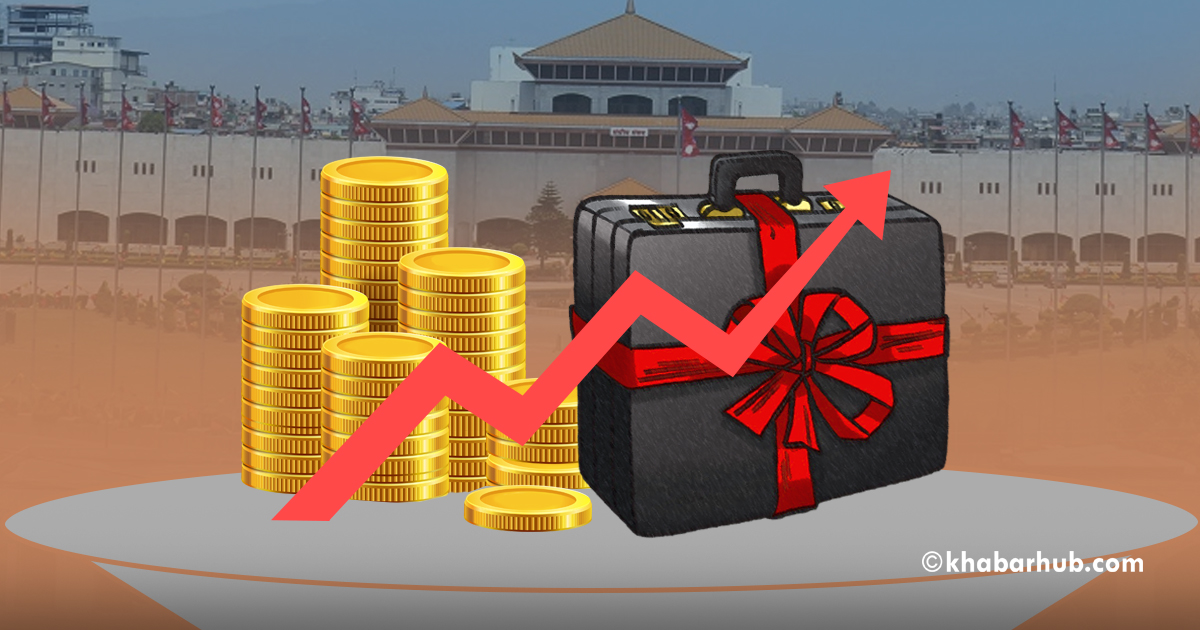Finance Minister Dr Yuvraj Khatiwada in the country’s annual budget for the fiscal year 2019/20 has announced NRs 957.1 billion as current expenditure which includes government spending on mainly wages and salaries. The rising level of current expenditure is worrisome, especially when compared with capital expenditure (408.9 billion) which is less than half of the total current expenditure.
What does it actually mean for the next financial year? It means that the government’s final consumption expenditure on goods and services for current use far exceeds the government investment i.e. capital expenditures (or fixed capital formation) within the country.
The government, through the current budget 2019/20, has imposed restrictions on long term future benefits accruing from building infrastructure within the country such as transport (roads, rail airports), health (water collection and distribution, sewage systems, communication (telephone, radio and TV) and research spending (defense, space, science and technology).
The budget of 1.532 trillion is another sad repetition of populism and political expediency as it has a worrisome level of transfer payments – the part of government spending that does not involve transactions of goods and services, but instead represent transfers of money for social security payments, pensions, and unemployment benefit.
For example, the announcements such as free of cost medical facilities at local levels, health insurance to all, old age allowance raised to NRs 3,000 per month covering not less than 13 hundred thousand senior citizens, single allowance hiked to 2000 NPR, 60 million NPR to each MP (Member of Parliament) in the name of ‘Constituency Development Fund’ and many other such schemes are one-sided payment without managing the ‘demand-side’ of economy.
The size of transfer payments and unmanageable level of current expenditure put together is more than double of capital expenditure is the ‘danger bell’ tolling for Nepal. Contraction of capital expenditures in the present budget is going to limit and retard the development of physical assets like roads, bridges, hospital buildings, and equipment without which no foreign investment is attracted to Nepal.
It is clear here that short term expenditure as recurring spending is far more than Capital expenditure which creates a lasting impact on the economy by laying the strong foundation of an efficient and productive economy. This is very relevant when Nepal is eyeing upon becoming a ‘middle-income country’ by 2030. Middle-income countries (MICs) are nations with a per capita gross national income (GNI) between $1,005 and $12,235.
As Finance Minister Khatiwada announced to raise the Per Capita Income of Nepalese citizens to the US $ 1364. Dr. Dadhi Adhikari, of ISSR (Institute for Strategic and Socio-economic Research), dubs this budget as ‘document of short vision’ and full of political rhetoric to consolidate the vote-bank within the country instead of showing any serious commitment to addressing the woes of Nepalese economy.
As private sectors in Nepal are still evolving with relatively weaker contributions in manufacturing sector and agriculture, it is imperative on part of government to spend more on building ‘assets’ as social capital (relating to ‘public goods’ such as roads and bridges along with ‘merit goods’ such as hospitals and schools).
Famous British economist John Maynard Keynes has argued that public spending should be increased when private spending and investment were inadequate. It is a common sense that the government will not be able to turn around the fate of sick industries and less-profitable agriculture unless tax-breaks and subsidies are provided to those working in these sectors.
Meager amount of 2.87 billion NPR has been allotted for industry that is to be distributed amongst several key areas which demand immediate attention such as promotion and prioritization of local products, reviving sick industries with the help of private sector, 5% interest subsidy in bank loans for garment industries, and setting up ‘challenge fund’ as an initial capital fund for new and small industry.
It challenges the basic understanding of finance and economics when the government of a country reduces the public spending way below its spending on social security. Is it the way to create ‘aggregate demand’ within the country where the majority of the population is dependent upon agriculture and suffering from poverty? The current budget proposes to spend just 34.80 billion NPR on agriculture and 64.5 billion on social security. Given the fact that Nepal is facing food-shortage every year and farmers are reeling poverty, more than double the amount was required to be allotted for agriculture with various kinds of programs aiming at empowering the farmers.
Buoyed by 6 percent growth for three consecutive years, the Government of Nepal has projected 7 percent of the growth in annual GDP (Gross Domestic Product) under the inflation rate of 4.5 percent. Assuming that everything goes fine for the government, the moot question remains as to how the financing of budgetary schemes is going to be met in face of yawning current account deficit, faltering foreign investment and withdrawal of grants by foreign countries.
Why don’t we understand that reducing the trade with India and replacing the same with China is not going to reduce excessive imports over minuscule exports unless we spur our own domestic economy by strengthening the core sectors of manufacturing and agriculture?
As the budget stresses trading with China in no uncertain words, it is silent on how to lessen our imports and increase our exports by being self-dependent in light of lesser allotment of budgetary money for agriculture, manufacturing and service sectors.
Senior economist Dr Adhikari warns the government against inflating the overall budgetary outlay for vending populist schemes whose futures, like before, remain uncertain because it dissuades the foreign countries from financing them by releasing grants and making an investment. Fear of populism taking over real commitment to building the domestic economy of Nepal always looms as economic survey 2018-19 reveals that every Nepali is carrying the debt of NRs 34,315 (per capita debt).









Comment